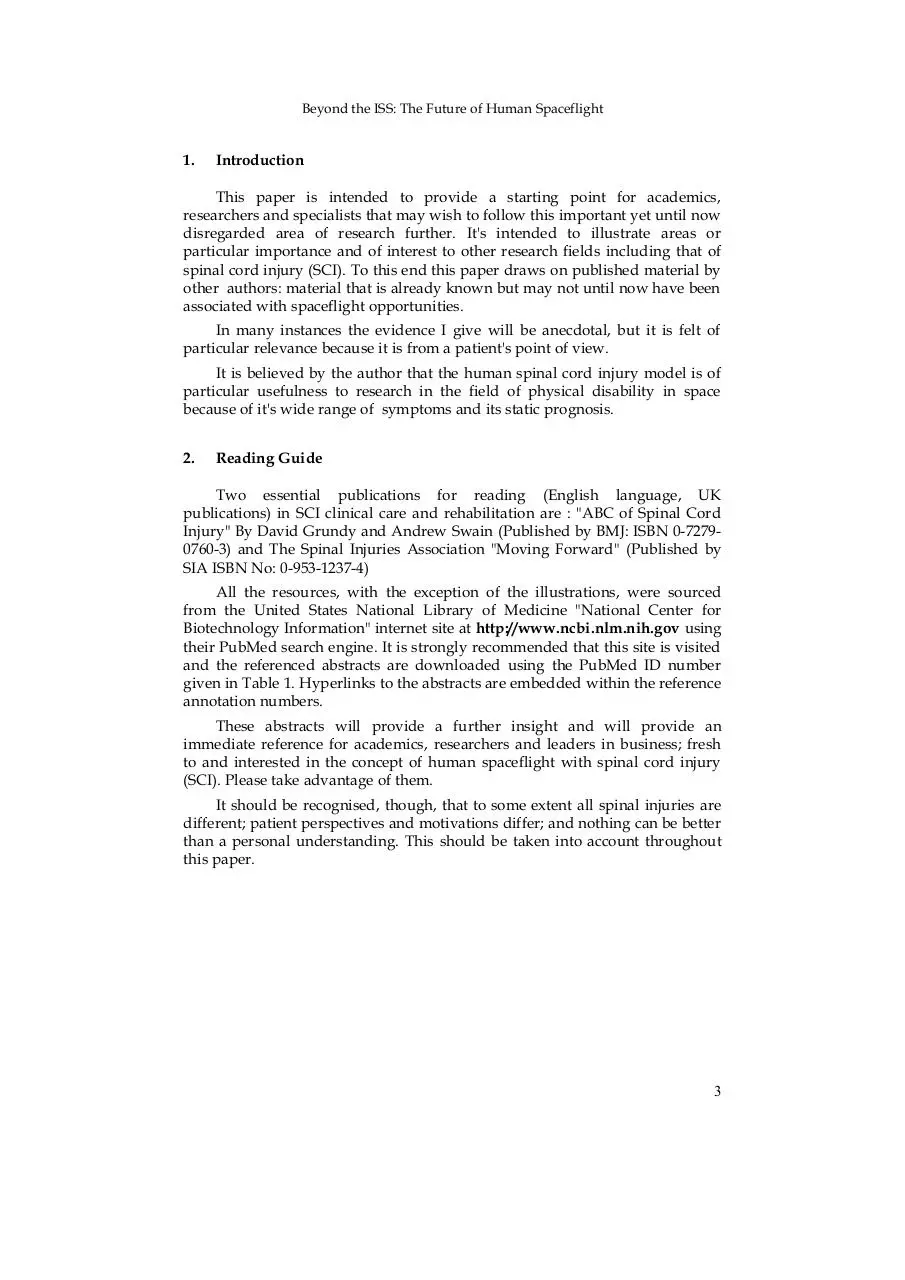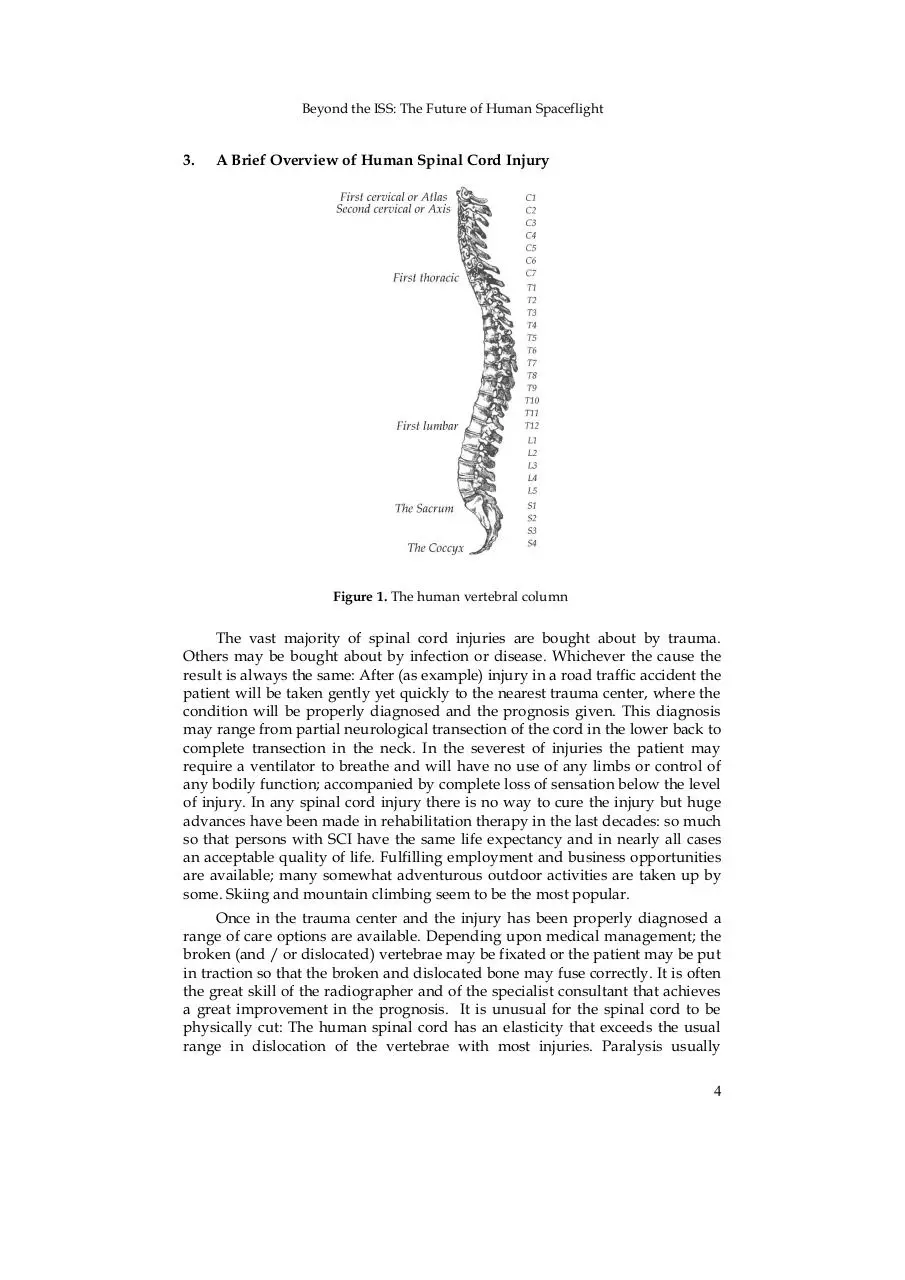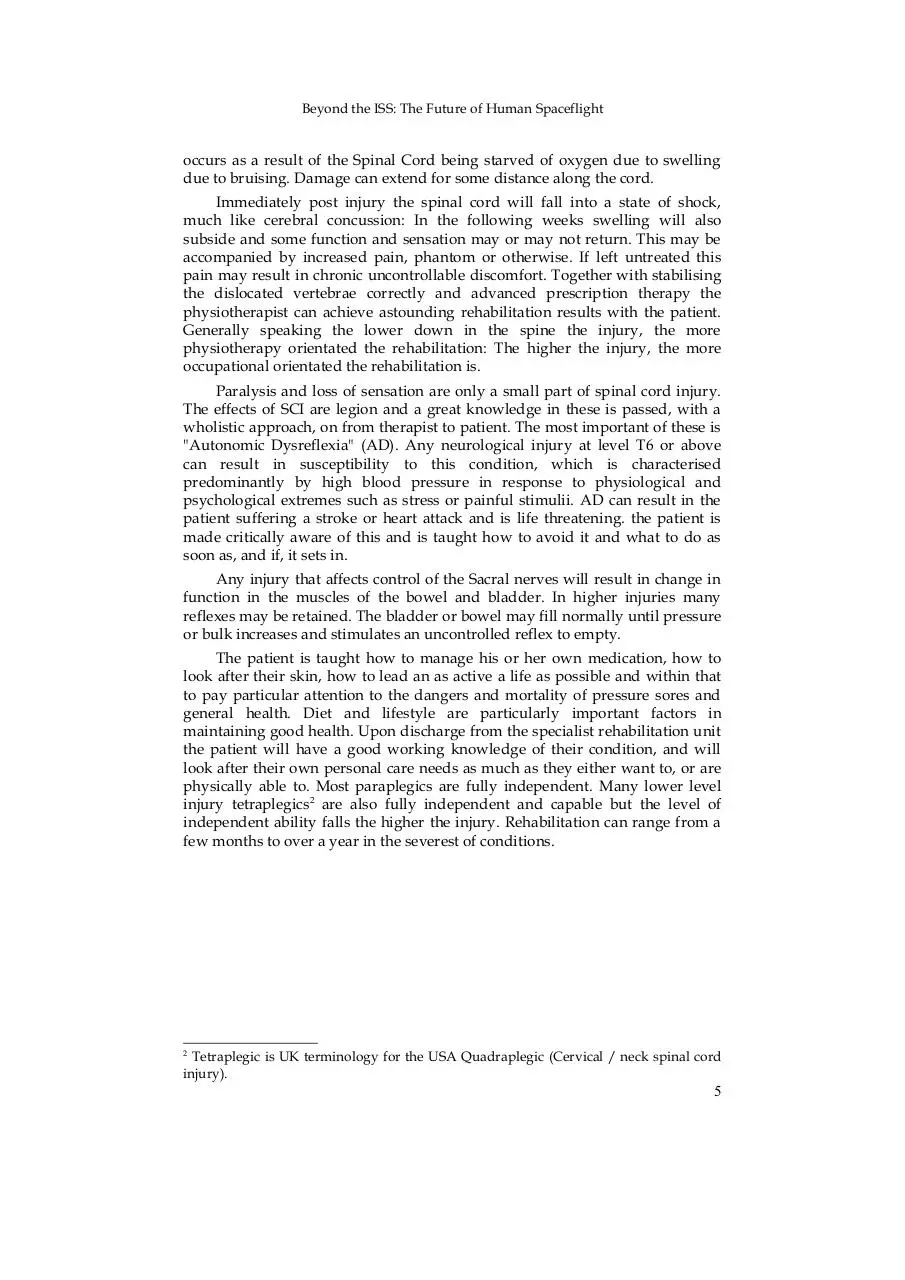R I Tylor ISU 2002 FINAL (PDF)
File information
Title: Physical Disability in the Microgravity Environment - Factors for consideration in the Human Spinal Cord Injury Model
Author: Mr Robert Ian Tylor
This PDF 1.4 document has been generated by Writer / OpenOffice.org 3.2, and has been sent on pdf-archive.com on 24/11/2013 at 17:50, from IP address 109.157.x.x.
The current document download page has been viewed 1136 times.
File size: 1.02 MB (25 pages).
Privacy: public file





File preview
Physical Disability in the Microgravity
Environment: Factors for Consideration in
the Human Spinal Cord Injury Model.
7th Annual International Symposium
International Space University
4 – 7 June 2002
Keywords: Spinal Cord Injury SCI Spaceflight Microgravity
Subject: The chronic SCI condition and it's concordance with
spaceflight research.
-Abstract
-Paper
-Study aids
-References
-Acknowledgements
-List of Symposium participants
Mr. Robert Ian Tylor.
Beyond the ISS: The Future of Human Spaceflight
Physical Disability in the microgravity environment:
Factors for consideration in the Human Spinal Cord
Injury model.
R. I. Tylor, The INSPIRE Foundation, The Duke of Cornwall Spinal Treatment Center,
C
/O Salisbury District Hospital, Salisbury, Wiltshire, SP2 8BJ, United Kingdom
e-mail: r.tylor@btinternet.com
Abstract
This paper outlines preliminary areas of discussion in the relationship between
human venture into space and the microgravity environment and physical disability, in
particular high thoracic complete neurological dysfunction due to spinal cord injury
(SCI). (As example)
The purpose of this paper is to present a disregarded yet vital research
opportunity and to provide a starting point for academics that may be wish to explore
this area further. A brief overview of the effects of spinal cord injury and perceived
complications and research benefits in human SCI 1 spaceflight are given. Spinal cord
injury has been chosen as the research model because: 1/. Many of the effects suffered
by persons with a chronic SCI condition are comparable to those suffered by ablebodied persons during spaceflight; 2/. The areas of healthcare already under study in
microgravity can be well complimented by studying the reaction of the SCI condition in
microgravity; 3/. Persons with SCI are (generally speaking) otherwise completely fit
and healthy; even so far as SCI is no longer regarded at an unhealthy (or sick) condition;
4/. The effects of SCI are static and well documented.
As well as being drawn from both personal and personally acquainted life
experiences, the text also has references drawn from other published articles that
support the hypothesis that persons with SCI may well be better suited to long term
habitation of the microgravity environment. This paper reveals the human chronic SCI
model in microgravity as a good research sample for investigations into these research
topics: 1/. Osteoporosis. 2/. Muscle degenerative disorders. 3/. Cardiovascular
function. 4/. Pulmonary function. 5/. Autonomic function 6/. Metabolic and renal
function 7/. Neural plasticity. 8/. Sleep disorder 9/. Activities of daily living. Two
further topics introduced are the social and cultural understanding of disability and
solo parachute freefall with paraplegia.
Upon that it describes physiological effects and side effects of high thoracic (and
lower) neurological dysfunction due to spinal cord injury as not lying in contrast with
spaceflight opportunities: Indeed, many of the effects of long term habitation in a
microgravity environment by the so far able bodied pioneers are experienced
continuously by those living with physical disability in a +1g environment. Though
some of these might make spaceflight more enduring, others may make microgravity
habitation, and indeed recovery from it easier than it is for the able bodied and certainly
easier than disabled habitation of a +1g environment. Few activities of daily living
become impossible. Even in the most extreme examples of bowel and bladder
dysfunction; human ability has provided solutions. Early pioneers of Space were
presented with awkward pre-requisites for adaptation of personal care, and sometime
quite similar to personal care within SCI bowel/bladder dysfunction. Spaceflight may
be inhibited if routines cannot be adjusted to accommodate the new conditions, but
overbearing adaptation of already well practiced personal routines may not be
necessary.
Importantly, there is a massive cultural understanding to be gained from the
knowledge that it is our own earthbound annealed environment that dictates the
refinements of physical disability.
It is the conclusion of this paper that the benefits of exploring microgravity
habitation with a physical disability such as spinal cord injury outweigh the pitfalls,
and that not only spaceflight and medical research but also the “human experience”
would greatly benefit from exploring this option. There are no apparent prohibitive
contraindications to human SCI spaceflight.
1
Denotes Spinal Cord Injury
2
Beyond the ISS: The Future of Human Spaceflight
1.
Introduction
This paper is intended to provide a starting point for academics,
researchers and specialists that may wish to follow this important yet until now
disregarded area of research further. It's intended to illustrate areas or
particular importance and of interest to other research fields including that of
spinal cord injury (SCI). To this end this paper draws on published material by
other authors: material that is already known but may not until now have been
associated with spaceflight opportunities.
In many instances the evidence I give will be anecdotal, but it is felt of
particular relevance because it is from a patient's point of view.
It is believed by the author that the human spinal cord injury model is of
particular usefulness to research in the field of physical disability in space
because of it's wide range of symptoms and its static prognosis.
2.
Reading Guide
Two essential publications for reading (English language, UK
publications) in SCI clinical care and rehabilitation are : "ABC of Spinal Cord
Injury" By David Grundy and Andrew Swain (Published by BMJ: ISBN 0-72790760-3) and The Spinal Injuries Association "Moving Forward" (Published by
SIA ISBN No: 0-953-1237-4)
All the resources, with the exception of the illustrations, were sourced
from the United States National Library of Medicine "National Center for
Biotechnology Information" internet site at http://www.ncbi.nlm.nih.gov using
their PubMed search engine. It is strongly recommended that this site is visited
and the referenced abstracts are downloaded using the PubMed ID number
given in Table 1. Hyperlinks to the abstracts are embedded within the reference
annotation numbers.
These abstracts will provide a further insight and will provide an
immediate reference for academics, researchers and leaders in business; fresh
to and interested in the concept of human spaceflight with spinal cord injury
(SCI). Please take advantage of them.
It should be recognised, though, that to some extent all spinal injuries are
different; patient perspectives and motivations differ; and nothing can be better
than a personal understanding. This should be taken into account throughout
this paper.
3
Beyond the ISS: The Future of Human Spaceflight
3.
A Brief Overview of Human Spinal Cord Injury
Figure 1. The human vertebral column
The vast majority of spinal cord injuries are bought about by trauma.
Others may be bought about by infection or disease. Whichever the cause the
result is always the same: After (as example) injury in a road traffic accident the
patient will be taken gently yet quickly to the nearest trauma center, where the
condition will be properly diagnosed and the prognosis given. This diagnosis
may range from partial neurological transection of the cord in the lower back to
complete transection in the neck. In the severest of injuries the patient may
require a ventilator to breathe and will have no use of any limbs or control of
any bodily function; accompanied by complete loss of sensation below the level
of injury. In any spinal cord injury there is no way to cure the injury but huge
advances have been made in rehabilitation therapy in the last decades: so much
so that persons with SCI have the same life expectancy and in nearly all cases
an acceptable quality of life. Fulfilling employment and business opportunities
are available; many somewhat adventurous outdoor activities are taken up by
some. Skiing and mountain climbing seem to be the most popular.
Once in the trauma center and the injury has been properly diagnosed a
range of care options are available. Depending upon medical management; the
broken (and / or dislocated) vertebrae may be fixated or the patient may be put
in traction so that the broken and dislocated bone may fuse correctly. It is often
the great skill of the radiographer and of the specialist consultant that achieves
a great improvement in the prognosis. It is unusual for the spinal cord to be
physically cut: The human spinal cord has an elasticity that exceeds the usual
range in dislocation of the vertebrae with most injuries. Paralysis usually
4
Beyond the ISS: The Future of Human Spaceflight
occurs as a result of the Spinal Cord being starved of oxygen due to swelling
due to bruising. Damage can extend for some distance along the cord.
Immediately post injury the spinal cord will fall into a state of shock,
much like cerebral concussion: In the following weeks swelling will also
subside and some function and sensation may or may not return. This may be
accompanied by increased pain, phantom or otherwise. If left untreated this
pain may result in chronic uncontrollable discomfort. Together with stabilising
the dislocated vertebrae correctly and advanced prescription therapy the
physiotherapist can achieve astounding rehabilitation results with the patient.
Generally speaking the lower down in the spine the injury, the more
physiotherapy orientated the rehabilitation: The higher the injury, the more
occupational orientated the rehabilitation is.
Paralysis and loss of sensation are only a small part of spinal cord injury.
The effects of SCI are legion and a great knowledge in these is passed, with a
wholistic approach, on from therapist to patient. The most important of these is
"Autonomic Dysreflexia" (AD). Any neurological injury at level T6 or above
can result in susceptibility to this condition, which is characterised
predominantly by high blood pressure in response to physiological and
psychological extremes such as stress or painful stimulii. AD can result in the
patient suffering a stroke or heart attack and is life threatening. the patient is
made critically aware of this and is taught how to avoid it and what to do as
soon as, and if, it sets in.
Any injury that affects control of the Sacral nerves will result in change in
function in the muscles of the bowel and bladder. In higher injuries many
reflexes may be retained. The bladder or bowel may fill normally until pressure
or bulk increases and stimulates an uncontrolled reflex to empty.
The patient is taught how to manage his or her own medication, how to
look after their skin, how to lead an as active a life as possible and within that
to pay particular attention to the dangers and mortality of pressure sores and
general health. Diet and lifestyle are particularly important factors in
maintaining good health. Upon discharge from the specialist rehabilitation unit
the patient will have a good working knowledge of their condition, and will
look after their own personal care needs as much as they either want to, or are
physically able to. Most paraplegics are fully independent. Many lower level
injury tetraplegics2 are also fully independent and capable but the level of
independent ability falls the higher the injury. Rehabilitation can range from a
few months to over a year in the severest of conditions.
2
Tetraplegic is UK terminology for the USA Quadraplegic (Cervical / neck spinal cord
injury).
5
Beyond the ISS: The Future of Human Spaceflight
4.
Osteoporosis
Figure 2. Normal bone
Figure 3. Osteoporotic bone
(Pictures courtesy of ERISTO: European Research in Space and Osteoporosis).
Extensive research has been conducted to evaluate osteoporosis in bedrest, spinal cord injury [References 1, 2, 3, 4, 5]3 as well as in microgravity
[References 6, 7, 8, 9]. In order to better understand how microgravity effects
the human skeleton it may be better to study how the human chronic 4 spinal
cord injured skeleton reacts under microgravity conditions. This could benefit
research in age related and spaceflight skeletal degenerative conditions as well
as support the hypothesis that the chronic immobile spinal cord injured
skeleton is better suited to spaceflight than the able-bodied.
It seems that decreases in bone density due to chronic spinal cord injury
vary widely from individual to individual. Decrease appears due in the larger
part to the absence of load bearing rather than purely the paralysed condition.
The main influences on this variation are recorded as being metabolic activity
and type and length of physical activity 5. Physical activity may include muscle
spasticity. Decrease in bone density appears to approach stasis in most cases
(though sometimes near fracture).
It could be hypothesised that if a human spinal cord injured (paralysed)
subject with a near stabilised decrease in bone density in the lower extremities
and lumbar region were to be exposed to microgravity, then there may be no
further decrease or at least any microgravity influenced decrease in bone
density may be less severe. Imbalances caused by bone degeneration may be
avoided. A chronic (human) paraplegic may have better skeletal durability to
spaceflight.
The recommendation is that a suitable spinal cord injured subject is found.
A suitable subject would have a stabilised bone density, and bone density
should not be near / at or approaching fracture: Once this has been established;
and considering that rates of osteoporosis are seen to vary across cross-sections
3
These numbers are hyperlinked to the referenced abstracts in the electronic copy.
Please connect on-line and click on the digit if you have it.
4
The time post for change from the acute condition to the chronic condition appears to
be largely subjective and varies from case to case. Chronic, in this paper at least, refers to
the extended more settled condition.
5
Excepting in the upper limbs and torso where there appears to be a genetic predisposition for resistance to osteoporosis.
6
Beyond the ISS: The Future of Human Spaceflight
of subjects, their bone density should be recorded at specific points above and
below their level of injury and then exposed to microgravity in two stages. The
shorter duration should give an early indication of any serious detrimental
effects of microgravity to bone density. If all goes well a longer (90 day or
more) study should then be undertaken. Immediately after each exposure to
microgravity bone density should be measured again; and the results
compared to able-bodied spaceflight samples. Within this data collected there
should be a record (diary) of any muscle activity6.
The data gained would provide for better interpolation of data recorded
on the effect of microgravity on bone density in able bodied spaceflight, better
supporting studies in immobilisation osteoporosis; by separating the effects of
microgravity from acute immobilisation.
5.
Muscle Degeneration
Muscle degeneration, whether due to spinal cord injury or spaceflight can
be severe. It is well recognised that muscle loss is variable and rapid
[References 10, 11, 12]. Some influence on the rate and extent of muscle atrophy
is unusual muscle activity (commonly referred to as spasticity) due to
neurological dysfunction. Changes differ between type and function of muscle
fibers [Reference 13]. Further influence on spasticity might be changes in
calcium handling [Reference 14]. Complications can arise as a result of
decreases in muscle bulk and some of this is described later 7. Innovative
general and local treatment for severe muscle spasticity can be found in
[References 15, 16].
Muscle atrophy whether due to spinal cord injury paralysis or from
microgravity disuse [References 17, 18, 19, 20, 21] falls within similar
boundaries. Chronic paralysis results in a far greater deterioration in the
quality and bulk of human muscle fibers than due to bed rest only. (Indicating
that neurological "completeness" itself contributes to good muscle tone.) This
loss is still to some extent recoverable; though most recovery so far gained has
been with Functional Electrical Stimulation. Recovery from long term ablebodied spaceflight may result in a near normalised condition but in the absence
of exercise, and by that is meant intense exercise, muscle atrophy will be severe
and recovery can be slow.
If a spinal cord injured person were to inhabit a microgravity environment
that person may not have to undergo the same intense exercise routines to
maintain their already markedly reduced muscle tone / bulk. The SCI person
would not only have more time for maintenance or research duties, but may
also have a shorter (or need no) recovery period 8 post-flight. However, it is
important to recognise that a paraplegic exercise their upper limbs: Even
though the course of the normal working day may provide enough exercise to
prevent extensive upper limb muscle atrophy under able-bodied conditions; on
return to Earth the paraplegic will use their upper limbs in different ways, and
so will need to maintain a different type of upper limb function. It is important
to note that in the course of a paraplegic's normal day it isn't so much brute
6
See "Muscle Degeneration".
Cardiovascular function.
8
Recovery to pre-flight condition.
7
7
Beyond the ISS: The Future of Human Spaceflight
force that is needed, but flexibility / suppleness and stamina. For me, the most
useful physiotherapist routines for the paraplegic model was pushing down on
a pullied load with laterally extended arms 9; and in a floor-seated position,
with legs out-stretched forwards, raising the backside off the ground as high as
possible by using the arms with full downward shoulder extension. These
exercises aid transfers and that ability should not be lost. Spaceflight exercise
routines should accommodate these.
My main concern with muscle activity in spinal cord injured spaceflight
would be that of spasticity. Spasticity in spinal cord injury is particularly
prevalent in incomplete higher level injuries. In extreme cases an incomplete
paraplegic or tetraplegic patient that may otherwise have useful function of the
limbs can be almost completely debilitated by their spasticity if it is left
untreated10. There may be problems with contracture and increased shaking of
the limbs leading to impaired passive mobility and decreases in comfort and
cosmesis.
Spastic contracture may occur in paralysed limbs if the brace effect of a
snuggly fitting wheelchair is left behind, especially if the subject has used a
wheelchair for many years. It could also be very useful to have a light-weight
leg-torso brace fitted to inhibit over extension of the legs and back. This could
also aid mobility in microgravity by making for a more stable posture.
Anecdotal evidence from myself and from other spinal cord injured persons I
have come to know suggests that leading an active and mobile lifestyle on it's
own often results in improved (lessened) spasticity. Exercise of the paralysed
limbs should be taken in microgravity, but the assumption can be made that
exercise needn't be anything like as intense or load-bearing as in able-bodied
spaceflight. Many SCI patients have improved lower limb muscle bulk and
blood flow due to some spasticity in the legs and improved stability from mild
spasticity in the torso: Often a careful balance between useful and detrimental
spasticity is maintained, and in nearly all cases medication or other (exercise)
therapy is governed by the patient11.
6.
Cardiovascular Function
The effects of spinal cord injury on cardiovascular function [References 22,
23, 24, 25, 26] and the effect of microgravity on cardiovascular function
[References 27, 28, 29, 30] are shown to differ. A better knowledge of the
mechanisms behind these differences and a better knowledge of the common
links between them could benefit human long term microgravity habitation
and Earth based medical research. This section gives an overview of some of
9
This exercise strengthens the Latissimus Dorsi muscles, a sprung load should be used
in place of "weights" in microgravity.
10
Pharmaceuticals used to control spasticity in SCI include Baclofen , Dantrolene,
Valium and more modernly intramuscular Botulinum toxin. In extreme cases the
peripheral nerves may be surgicaly severed to break the neurological loop that enables
uncontrolled reflexes to take hold. Research into the use of Cannabinoids to control
spasticity is currently ongoing with some success.
11
Anecdotal evidence suggests that a wholistic approach is taken, and that even passive
mobility relieves severe spasticity.
8
Beyond the ISS: The Future of Human Spaceflight
the common ground and areas of interest in studying spinal cord injury
cardiovascular function in microgravity.
A major influence on blood flow in spinal cord injury is muscle disuse
rather than change in cardiac output: A common result of the absence of the
pumping action by the leg muscles is odema in the lower leg and foot.
Spaceflight seems to result in a more headward shift of (and decrease in) fluid
volume. This is described as being similar to that of a siting position. It would
be interesting to know what change in volume and flow occurs in the
paraplegic model when exposed to microgravity. Would venous return be
improved? Would fluid volume decrease further? Pressures and cardiac output
would appear to remain the same or closely similar. So if a cause (gravity) of
poor venous return in SCI were to be removed, flow may be more equalised.
Blood flow in the lower limbs may even be improved, leading to a reduced
likelihood of thrombosis in the paralysed legs and improved overall condition
of the legs and skin.
If cardiac output remains the same (or closely similar) in spinal cord injury
as well as in microgravity, and changes in blood flow differ under differing
causations, then it could be better understood how gravity and how muscle
disuse separately influence fluid volume (and shift) in microgravity (If it were
to be studied in a paraplegic in microgravity): Because recorded changes would
be measured in an already chronically immobile (disuse) system; the effect of
disuse in interpretation of collected data could be on the one hand nullified,
and with regard to previously collected data on the other; better understood.
7.
Pulmonary Function
Pulmonary function is obviously an important aspect of wellness. Both are
disrupted, and in different ways, by spinal cord injury [References 31, 32, 33]
and by microgravity [References 34, 35, 36]. Correlations and differences can be
drawn between these two differing mechanisms by paying regard to the given
abstracts.
Changes in lung capacity and tidal volume in SCI appear to be due to
posture as well as paralysis. Paralysed subjects normally have a degree of
difficulty in achieving full breath and exercise has little or no effect on lung
capacity.
A greater level of uniformity in lung capacity appears to arise in
microgravity. It could be assumed that the removal (due to microgravity) of
some internal weight bearing pressures and a more beneficial posture (i.e. not
seated) might improve lung capacity. Quite what this effect might mean to the
paralysed subject in microgravity (and indeed closely linked vascular function)
is unclear. Pulmonary function may be improved, but what benefit this may
mean to oxygenation can only be discovered by undergoing spaceflight.
Hypothetically though, if microgravity does remove some of these internal
weight bearing pressures; and thus make breathing 'easier' for a SCI subject:
Then with regards to pulmonary function, and considering the chronic state of
SCI immobilised physiology the effect of microgravity may be less detrimental
than in a "fit / healthy" non-paralysed physiology. Only an in-flight study
would clarify this.
9
Download R I Tylor ISU 2002 FINAL
R_I_Tylor_ISU_2002_FINAL.pdf (PDF, 1.02 MB)
Download PDF
Share this file on social networks
Link to this page
Permanent link
Use the permanent link to the download page to share your document on Facebook, Twitter, LinkedIn, or directly with a contact by e-Mail, Messenger, Whatsapp, Line..
Short link
Use the short link to share your document on Twitter or by text message (SMS)
HTML Code
Copy the following HTML code to share your document on a Website or Blog
QR Code to this page

This file has been shared publicly by a user of PDF Archive.
Document ID: 0000136273.